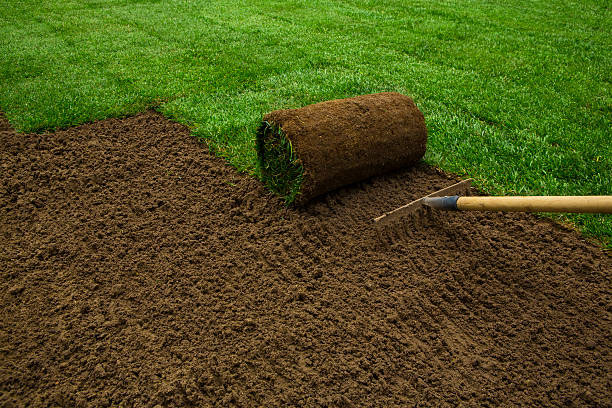
What is Sod?
Sod, also referred to as ’turf’, is grass with soil beneath, held together by its roots. It is grass seed grown by professionals in rich soil, cut into manageable pieces, and rolled out like a rug in neighborhoods all across the country. Different types of sod will do better in some climates then others. Our sod is perfect for the Midwest and will thrive in cold winters and hot summers.
Sod or seed?
We all have a decision to make when it comes to establishing a lawn or repairing our existing lawn: Should I sod or seed? There are two major factors involved in deciding whether to sod or seed. Cost is the first. Sod is the more expensive option because you are essentially paying for a completed product. Someone else has already done the growing for you. You just have to lay it out and keep it watered until it is established. Seed is a lot cheaper per square foot then sod but it does require a little more effort. Which brings us to the second factor: Time. Sod is instant. While the roots take about 2 weeks to establish, you and your pets can walk on sod immediately. Seed, however, will take between 7 to 30 days to begin germinating. Weather, type of seed and the condition of your soil can all affect how fast your grass grows. You and your pets will need to steer clear of the area until the seed is tall enough to mow. If the seed for some reason, does not take in some spots or if some of the seed washes away, you may need to reseed. We recommend using a seed blanket or EZ Straw when seeding. EZ Straw has three benefits: 1) it protects the seed from heavy washout, windy areas, birds and other animals, 2) it holds water and keeps the seed moist which will speed up germination, and 3) it is biodegradable so there is no mess to clean up.
How much sod do I need?
This is the easy part! All you need is the square footage (length x width) of the area you are trying to cover. If you have multiple areas, determine the square footage for each individual area and then add the areas together to find your total square footage. Our sod is cut into 2’ x 5’ rolls which equal a total of 10 square feet. For example, if you have an area that is 5’ x 30’, your square footage is 150’. Divide 150 by 10 and you get 15. In this case, you would need 15 rolls of sod to cover that area.
How do I install Sod? Follow these simple steps:
- Prepare the soil. It is best to kill any existing vegetation. This will reduce the competition for the newly planted sod. If you use a weed killer, be sure to read the entire label. Some weed killer products require a waiting period after use before planting in that area again. In most cases, you should not apply weed killer and then immediately plant sod as the weed killer may damage the roots.
- Loosen the soil before planting by using a rake or a rototiller. This allows the roots of the sod to grow into the soil. A loose soil will hold moisture better, will help avoid runoff, which will reduce the amount of water you use.
- Use a metal rake to smooth and level out the soil. Add additional soil where needed.
- Apply a starter fertilizer. We recommend using Milorganite or Jonathan Green’s Green Up Fertilizer for Seeding and Sodding.
- Lay the sod. Start on the end farthest away and work your way towards you. Sod can be easily cut using a utility or similar knife. For a more professional look, stagger the sod. This will help hide the seams while the sod grows together. Butt up the sod against each other without overlapping. This will ensure a smooth finish and lessen the gaps between rolls.
- Use a sod roller. This is optional however it is recommended for larger areas. A sod roller can be used to help smooth the soil before laying the sod. It can also help smooth the sodded area after it is planted. If you have prepared the soil well enough, you mostly likely will not need to use a sod roller. Alternatively, walking the seams after laying the sod, will also help ensure all of the edges are down and have connected with the ground.
Finally, water, water, water! Watering the first two weeks after planting sod is crucial. You need to keep the soil moist. This means in hotter months, you will need to water the sod daily. Cooler months will require less frequent watering. Let about 1 – 1 1/2” of water soak into the sod each time you water. You can measure this by using a rain gauge or a can. You can also lift a corner of the sod to see if the water has soaked down to the roots. If it is soaked all the way through, you know your sod is getting enough water. But don’t water too much! Puddles are a good indication that you are watering too much. If the water is getting down to the roots of the sod but you see puddles forming, then cut back on your watering.